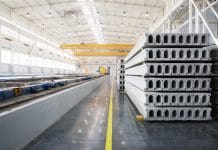CITB’s Future Skills Strategy Manager Ben Lever tells PBC Today about the research being conducted into the provision of offsite construction training
In April this year, the CITB released its report, ‘Faster, Smarter, More Efficient: Building Skills for Offsite Construction’ which showed that 42% of construction industry employers with over 100 staff expect to use offsite methods in five years’ time. It also showed that nearly 50% of construction industry clients expect the use of offsite construction to increase over the next five years.
With this increasing interest in moving to offsite methods of construction, the question of how we train the workforce required is answered in the report from the CITB. The research is well-timed, following on from the Farmer Review and tying into government announcements and initiatives discussing the use of offsite construction.
PBC Today caught up with Ben Lever, Future Skills Strategy Manager at the CITB to delve into the provision of offsite construction training.
There seems to an increasing argument that offsite construction holds many of the answers for the future of the construction industry, but how much is delivered through this method?
Regarding uptake across the UK, our research indicates that around 10% of total construction output is from offsite construction. Some sectors are higher than others. For example, offsite construction is higher in the housing sector. As a proportion, it’s small but not insignificant. Our research has shown that along with other indicators that it is increasing, and there are lots of drivers for change to increase offsite further.
Why has the UK been slower to adopt offsite than other European countries?
I think the answer is probably quite complex. There are certain features of the domestic market around the nature and fragmentation of the industry, and getting people to collaborate around new business models. The profit margins may also put companies off investing in the capital equipment required for offsite production. I don’t know if they are necessarily higher elsewhere, but this is a factor which has slowed adoption in the UK.
The risks associated with moving to a new model or a new way of doing things – when your profit margins are low – is often one that firms can’t stomach, but there are disrupters entering the market now to shake things up a bit.
Your research highlights that adopting offsite more widely is expected to change the skills and training landscape for construction, but in what way?
Through the research, we identified six key functions involved in offsite ranging from digital design at the start, through to the end of installation and erection on site and the management of that. We identified there would be some new roles – particularly when you’re looking at a factory setting. These would include manufacturing type roles – ensuring that the production line runs efficiently and that materials, sequencing and outputs are in line with the plans and digital models.
The way the research is presented – showing it as functional personas rather than job roles – reflects the flexibility in skills and roles for offsite. We are really pleased with the interest that’s been shown in the report and the positive response to the recommendations that will enable us to develop some much-needed activity in this area.
In part, we are looking at new manufacturing roles that are construction specific. That’s not to say we won’t need the traditional trades, but we will see a move toward multi-skilling, where an operative might be doing a number of tasks. For instance, there may be a requirement to take on plumbing, joinery and cladding roles, depending on how the production line is set up.
There will also be new requirements for onsite roles regarding tolerances, quality control, logistics, and handling. For instance, the ability to use digital technologies to aid craneage, positioning and groundworks still require traditional roles that are augmented to be able to serve those purposes.
How will multi-skilled training be delivered?
Depending on the growth of offsite, it could be a fundamental shift in how offsite construction training works. We have to define the degree to which someone is trained in multi-skills versus specialist skills. Our research is a start in mapping out those functions and trying to get an understanding of the spectrum of the skills needed within automation versus manual. It will evolve as technology develops.
It does present two fundamental questions: Is this about upskilling those existing in the industry, and to what degree do you supplement traditional courses with offsite related knowledge and skills?
For me, both of these are requirements, but there’s another question: Who delivers the training? Our research shows there is a shortage of qualified training providers and assessors.
A more flexible training structure is required which aligns to a degree with recent announcements on T- Levels and having a focus on vocational training. We need to provide a grounding in a number of techniques, skills and types of careers and allow the different pathways to be available, but not set or lock into those pathways too early on before a new entrant knows what’s available.
We need to provide courses where it’s possible to upskill too, and that requires presenting a choice and options as clearly as possible, but it is a shift in the content and style of training delivery – to new skills and behaviours and more flexible delivery – that isn’t fully there today.
What are the barriers to training for offsite skills?
One of the key things we identified and are going to address as a priority is the standards and qualifications that are out there in the industry.
Using our research as the basis, we will assess the existing suite of qualifications, including both offsite specific and more mainstream ones regarding their relevant content. From that, we will identify the gaps and any new standards and qualifications that need to be developed. The aim is to create frameworks and standards for the industry that new and augmented training courses can be built from.
We at the CITB have a responsibility and a role to help industry and avoid unnecessary duplication. We also intend to increase the mobility within the industry so one training course can be compared easily against another, and people have confidence in the currency of that training.
A key barrier is that current training is fragmented, where some qualifications are not fit for purpose at the level they need to be. The lack of offsite specific content and companies doing in-house training due to the lack of provision results in different approaches and standards.
Another barrier is the lack of people to do the training. Offsite construction is relatively new, so there are fewer experts available. Of those available, they are already in the industry, so there’s a real need to encourage those tutors to help teach the next generation and upskill the existing ones.
We are aware that we are funded by the construction sector, but much of what we are discussing is linked to manufacturing. We don’t have a body representing the end-to-end process. We recognise that and have said we will lead on the core construction elements, but we will also work with those organisations in the manufacturing sector to help them apply their standards and qualifications to a construction context. We are already in conversations with people there to see how we work together.
How crucial are digital skills?
Digital skills can mean many things, but specifically in construction when you think of digital you immediately think of BIM.
BIM and offsite go hand-in-hand, but it’s increasingly helpful to talk about digital rather than BIM. When you say digital skills and digital technologies, it’s a part of the planning and production line which is fed from a digital model.
The whole driver behind offsite are the improvements in quality and productivity. That’s the same as what BIM is doing – detailing and locking that design early on, agreeing on everything that’s there, and then running a schedule as set out in that plan and doing it on a production line type process.
‘Being’ digital also includes the use of apps on site to help with design and planning, or meeting health and safety regulations, which can be incredibly efficient. The CITB has an app on helping people comply with CDM regulations – it’s all part of the pathway to start using digital technologies. BIM is one part of being digital, but widening out the concept of digital is important.
Is embedding a different culture just as important as technical skills?
Our research shows that this is crucial. We have recommended that a competency framework is set up that focusses specifically on behaviours, attitudes and softer skills.
If you accept that individuals in the industry now need to be upskilled, one of the biggest changes for them is in the understanding of where they sit and how they act in the offsite construction process. Sequencing, timing and logistics are important to achieve efficiencies, so by having a behavioural mindset shift of doing things exactly to schedule is key.
The need to work collaboratively across various functions that operate in offsite is crucial – through digital design, talking to the site manager at the earliest possible stage, and the understanding of the need for quality assurance for every stage of the process. You can have all the equipment in place, and all schedules in place, but then it’s always down to the people doing the tasks to make sure they understand why things are done in a certain way, the importance of those tasks, and act accordingly.
Is industry ready for the change to offsite?
We see the CLC (Construction Leadership Council) making industrialisation, offsite and digitisation key priorities for what they do. So when they are looking at sector deals to the government, these topics are front and centre in their aims. They represent the industry to government, so that’s a fairly strong sign that industry is ready.
On the ground, I think you’re seeing pockets of offsite activity that are getting bigger. I don’t think it’s universally accepted as the future of construction, but there are companies that have invested and built new business models around it like Laing O Rourke, Skanska and L&G Homes.
Offsite activity also varies by sector. For housing, there’s lots more traction. Some people in infrastructure might ask why is this different as they’ve been making items like big precast tunnelling components in a factory for a long time. However, HS2 and Hinkley Point are looking to use offsite methods, so we can see a shift in how we can do that and industrialise what we do.
Overall, there is an increasing trend of readiness, but in some quarters there is still some resistance and counter arguments as to why it’s not right.
How does offsite construction training fit in with the CITB’s wider concerns of a construction skills gap?
In the interests of balance, offsite accounts for around 10% of total construction output so it needs to be put into the context of wider industry techniques and the skills we concentrate on. It’s not about saying that offsite becomes the new priority, but it is important and something we intend to address.
We are also engaged in how companies can claim back money through grants from the CITB and how the industrial strategy can be rolled out for skills and T-Levels. The offsite dimension needs to be included in all those conversations and not just be a tag-on.
In the bigger picture, offsite means greater productivity and quality. These are the end goals – being more productive, efficient and sustainable as an industry and offsite looks like a good way to get there through the use of digital means.
We continue to be involved in conversations about the skills gap and what we are doing to address it. Inevitably we see offsite as automation that requires fewer workers in some roles, but other new roles will emerge.
Offsite can help, in particular, with some of the major infrastructure projects like HS2 and Hinkley which can struggle to fill specific skills from a region. But, if offsite is utilised, we can tap into skills in different parts of the country and address any regional imbalances.
Offsite also represents a slightly different side to the industry. Our research shows it can present a new image and opportunities to people coming into the industry too. It offers different working conditions in a factory and roles like digital design, data analysis, robotics and factory production managers may appeal to a slightly different cohort to traditional construction roles.
There is a real opportunity there to attract more, younger people into the industry. If you’re into digital and data, there are more opportunities, and that helps to address that skills gap.
And finally
It’s our job to understand trends and to support industry training needs. It’s over to industry now to ask if this is for you? Is it something you want to embrace and does it work for you?
. . . . . . . . . . . . . . . . . . . . . . . . . . . . . . . . . . . . . . . . . . . . . . .

Ben Lever
Future Skills Strategy Manager
CITB
Twitter @CITB_UK














